

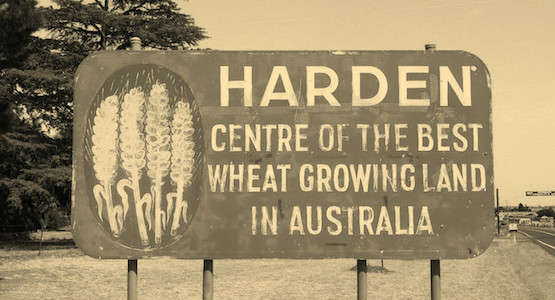
Driving from the East, the first sign of Harden is a large grain storage area beside the railway line at Cunningar. On entering the town, you are welcomed by a sign: "HARDEN, CENTRE OF THE BEST WHEAT GROWING LAND IN AUSTRALIA". This claim is based on a proud heritage of sustainable agriculture dating back to the late 1800’s.
This history is about to be disrupted.
Blantyre Farms (Murringo, Young Shire) has a proposal for a MEGA-PIGGERY in the middle of traditional agricultural land in the Harden Shire.
This proposal raises many issues.
Careful consideration needs to be given to which locations are suitable for intensive agriculture in the Harden Shire.
The most critical factor environmentally is to be able to deal with the waste in a sustainable manner.
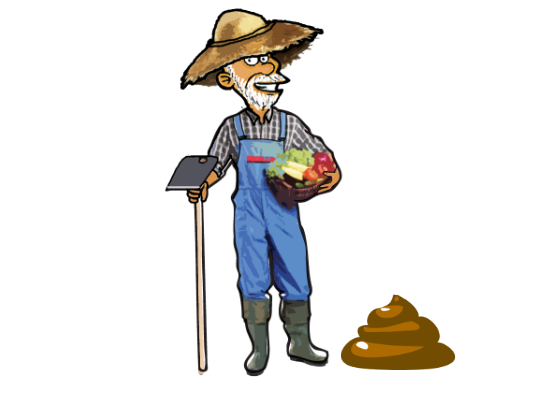 I produce 123 grams of faeces a day
I produce 123 grams of faeces a day
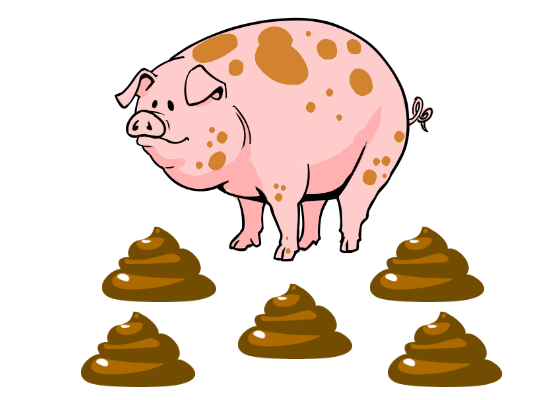 I produce 5x more waste. That's 224kg of poop a year!
I produce 5x more waste. That's 224kg of poop a year!
The mega-piggery will have up to 25,000 pigs - piglets, young pigs and adult pigs. That is a lot of manure in a small area! That is like having the sewerage that is produced from a city of 100,000 people sitting next to a vulnerable water course!
The sheds are flushed daily.
Manure and water are first stored in a large, covered manure pond. Breakdown of the manure forms biogas which is then used to generate power.
The sludgey remains are dried out over time in a sedimentation and evaporation pond system(SEPS).
This all seems to be a good idea. So what is the problem?
Whether this all works without having a negative impact on the environment depends on several things.
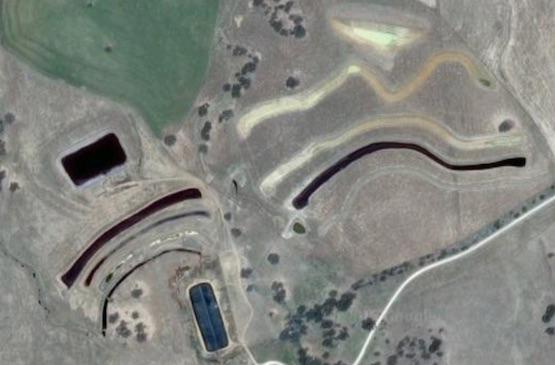 Aerial view of manure ponds on existing Blantyre Farms' Murringo site
Aerial view of manure ponds on existing Blantyre Farms' Murringo site
The manure ponds must hold water and not let the contaminants in the water leach into the groundwater.
It is not valid to use their Murringo site as evidence for effective operation at Harden because:
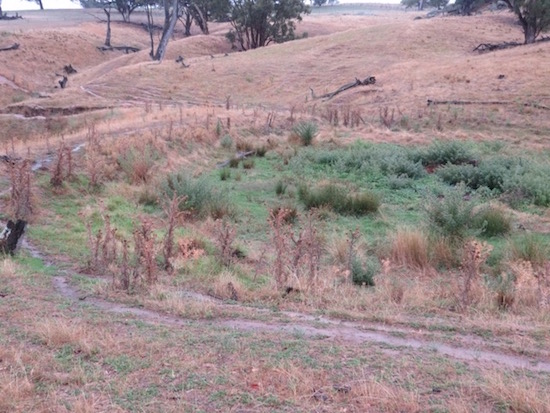 Dams on adjacent land to the proposed site have fallen into disuse as they DO NOT hold water. All adjoining land owners have stated that their dams leak despite being assured they 'should' hold water when constructed.
Dams on adjacent land to the proposed site have fallen into disuse as they DO NOT hold water. All adjoining land owners have stated that their dams leak despite being assured they 'should' hold water when constructed.
Not only does the soil type need to be good at sealing dams but it also has to hold and deal with the nutrients from the spread manure and irrigated effluent. On sloping sites the risk of runoff is high.
Relatively flat country, like at Murringo, is more suitable for intensive agriculture.
Topography has a major effect on the severity of runoff, dust and odour dispersion. In contrast to the relatively flat topography of Blantyre Farms' Murringo site, the Harden site is a typical sloping valley with gradients greater than 1:5 quite common. The Harden site will be prone to significant surface runoff, katabatic drift of odour and noise reverberation.
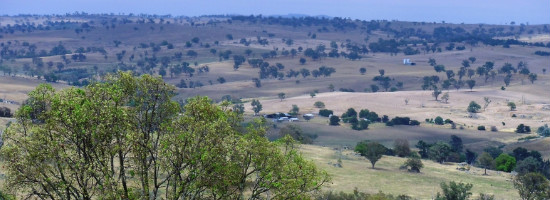 The Cunningham Valley
The Cunningham Valley
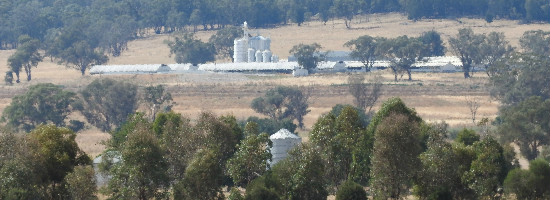 Blantyre Farms’ Murringo grower site
Blantyre Farms’ Murringo grower site
The proposed Harden site is located in the NSW groundwater vulnerable zone.
Many millions of litres of water will be used by the mega-piggery every year.
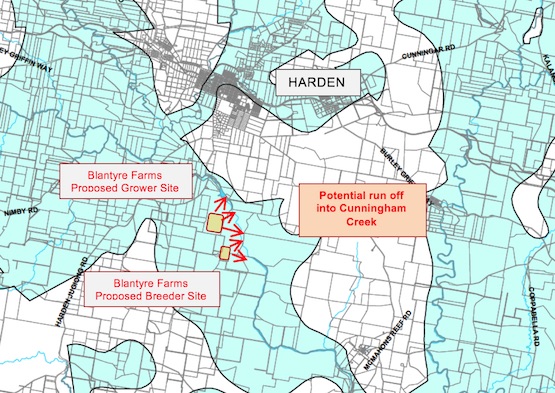 Blantyre Farms' proposed site relative to HSC vulnerable groundwater maps
Blantyre Farms' proposed site relative to HSC vulnerable groundwater maps
These issues of soil type, topography and the vulnerable groundwater zone, bring into question the environmental sustainability of this mega-piggery in this LOCATION.
There are also significant SOCIAL issues associated with the proposed Harden location. Over 96% of immediate and close surrounding neighbours have expressed concern and are raising many major issues.
The National Environmental Guidelines for Piggeries, 2010 gives recommended separation distances from piggeries to receptors – dwellings and public spaces.
An unreasonable odour impact is assumed to occur when separation distances between a mega-piggery and a receptor are less than those [recommended].
C.2.E p25 Blantyre Farms', Environmental Impact Study
The separation distance for four homes is less than the recommended separation distance (within margin of error).
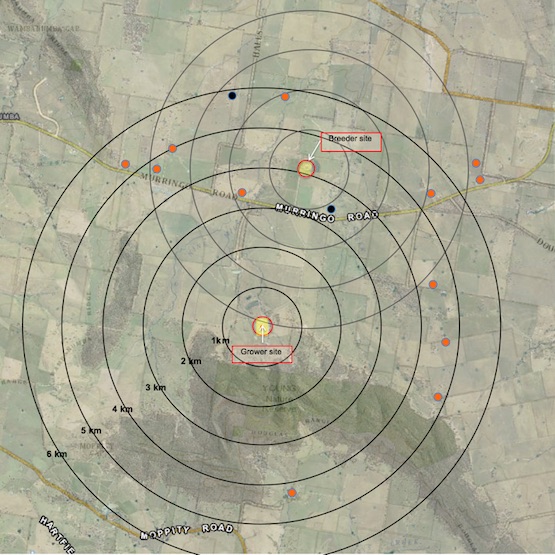 Murringo site: number of receivers within recommended separation distance = 0
Murringo site: number of receivers within recommended separation distance = 0
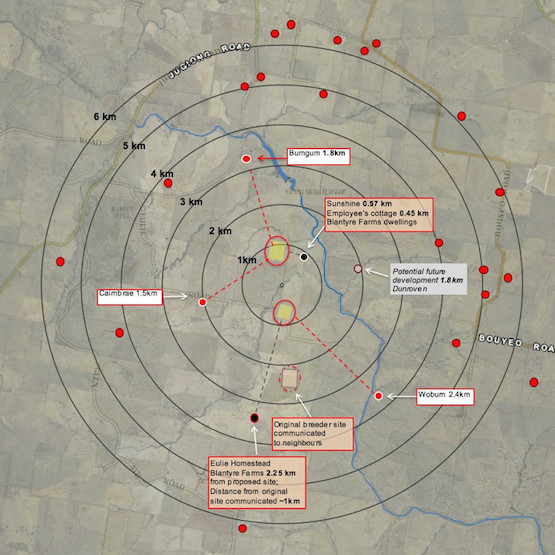 Harden site: number of receivers within the recommended separation distance = 4
Harden site: number of receivers within the recommended separation distance = 4
Blantyre Farms claim that they have not had any complaints at the Murringo site in the last 5 years. Again, a valid comparison cannot be made between Murringo and the proposed Harden site. The population density surrounding the site is more intense in Harden. The terrain and weather conditions are completely different.
The rate of complaints received cannot be used as a sustainability indicator, as it is an imprecise measure of Community Amenity Impacts.
p81 National Environmental Guidelines for Piggeries, 2010.
LOCATION of mega-piggery complex from Harden township
| --- | 6.6 km | Closest distance to the Harden PO |
| --- | 5.5 km | Closest distance to the first tee at Harden Golf Club |
| --- | 3.8 km | Closest distance from manure spreading to the first green |
LOCATION of mega-piggery complex in relation to Cunningham Ck
| → | Potential runoff into Cunningham Creek |
LOCATION of mega-piggery complex from Young & Murringo
Blantyre Farms' Murringo mega-piggery is:
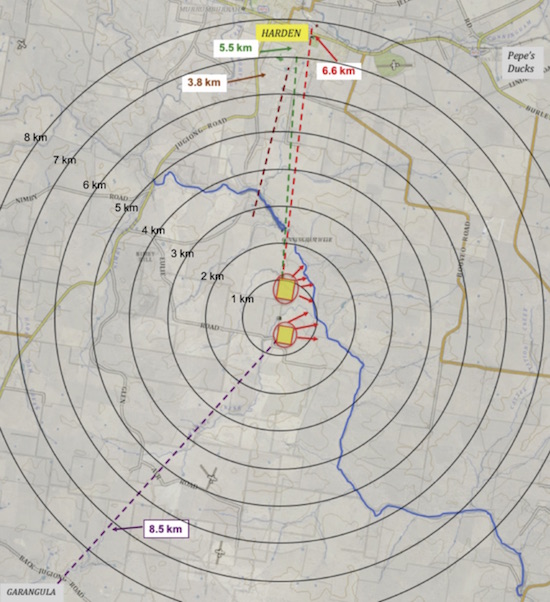 Location of mega-piggery complex from Harden township
Location of mega-piggery complex from Harden township
If this proceeds, it will be the first intensive farming introduced into the Cunningham Creek / Jugiong Creek Valley.
The rules and guidelines in the Harden Local Environmental Plan do not adequately address the specific issues that need to be considered with intensive agriculture.
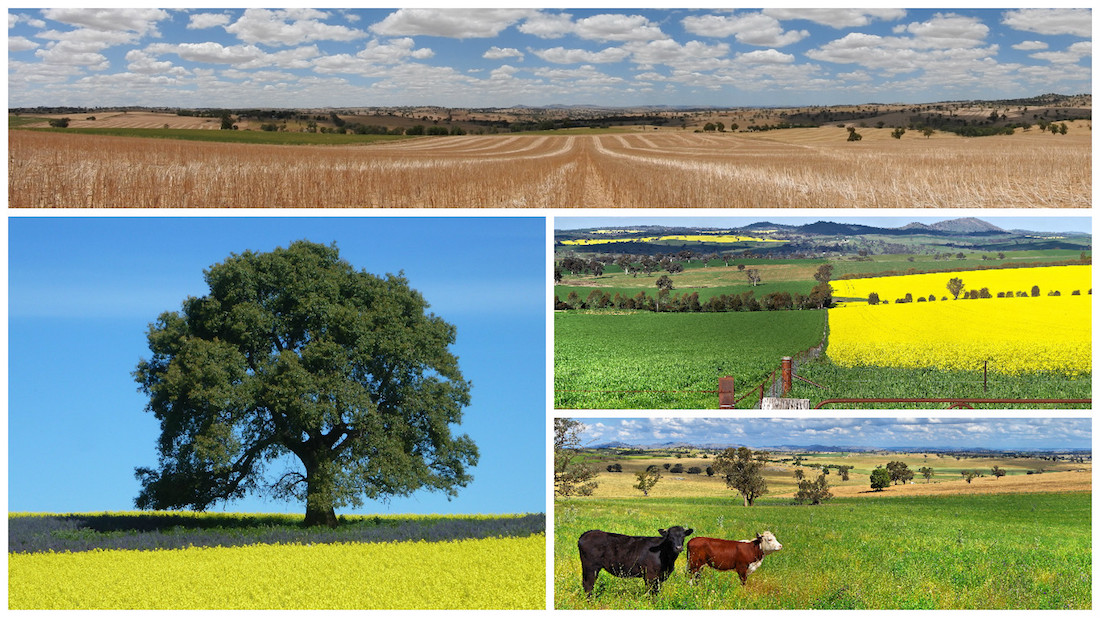
Why allow a mega-piggery into a groundwater vulnerable catchment?
Prevention IS Better Than Cure (The Precautionary Principal).
Jobs are important.
What is the certainty that employees will be sourced from Harden?
And at what cost to the environment?
Blantyre Farms' aspiration of Feeding the world
is a noble one.
The Harden Shire has been feeding the world for generations - sustainably!
The operational lifespan of the mega-piggery is expected to be around 25 years.
What legacy will this leave in 100 years?

On 18th December 2015 a public notice confirmed that a Development Application (DA) had been lodged with Harden Shire Council by Blantyre Farms (Edwina & Michael Beveridge). This DA proposes a large intensive mega-piggery situated on Eulie Road, Harden in the heart of the Cunningham Valley.
The proposed mega-piggery includes up to 25,000 pigs – both breeding and growing. Two (2) sites, approximately 1 km apart, will have a total of 21 sheds from 50 to 100m long and up to 5m high. Very large silos, a methane digestive system, extensive manure ponds, sedimentation & evaporation pond systems extend beyond the building complex. Effluent will be spread over the farm by irrigation and the spreading of dry manure to within 20m of watercourses that flow into Cunningham Creek.
If the mega-piggery goes ahead, Blantyre Farms state that 850-900 pigs will be transported weekly (250 pigs per semi-trailer) from Harden to Melbourne. That will mean approximately 2 semi-trailer movements per day within 8m of the front room of a farming family’s residence.. Additional traffic will occur associated with feed cartage and employee vehicles.
Significant community amenity & environmental impacts impose themselves on the local landowners including those houses on the southern edge of Harden township.
South West Slopes, NSW
The Cunningham Creek is formed by the confluence of Connaughtman's, Demondrille and Currawong Creeks and commences below Nimby Hill – flowing south to join the Jugiong Creek then the Murrumbidgee River at Jugiong. A distance of approx. 40 km.

The creek winds its way through mixed grazing & cropping farmland in an undulating open woodland of scattered eucalypts and patches of remnant native grassland. Yellow Box, White Box, Blakely’s Red Gum — many trees centuries old — are lightly studded on a stunning landscape.

Along the creek the 'Cunningham Weir', an extensive stretch of water, is an important breeding habitat for species of waterbirds, including the black swan. Just as important is its role as a resting, feeding and shelter area for migratory and transient bird species. Bird lists compiled prior to the 1980’s include over 80 different species on a yearly listing – additional species have been sighted since. Platypus are distributed intermittently along the length of the creek.

The water from Cunningham Creek joins the Murrumbidgee River and becomes the source of drinking water, managed by Goldenfields Water, for Harden-Murrumburrah and other communities west.

Multigenerational family farms adjoin the creek. The Soldiers Settlers blocks in this valley tell an important story in Australian History. Many heritage homesteads & farm buildings nestle in the undulating landscape. The "Jewel in the Crown" of Harden Shire, "Garangula" & "Redbank" (Romani Pastoral Co.), sit in the centre of this valley.
Who wants to live or work next to a mega-piggery?

A group of local landowners became aware of their mutual concerns about the mega-piggery proposal. This resulted in the formation of an action group on 28th December 2015 — THE CUNNINGHAM VALLEY ACTION GROUP (CVAG).
Protecting the natural beauty and sustainability of Cunningham Valley.
To act as custodians of the valley for future generations.
Respect:
Sustainability
Inclusiveness
The CVAG mission and objectives are closely aligned with the Harden Local Environmental Plan 2011
Cunningham Valley Action Group’s comprehensive research has allowed us to focus on understanding key issues that make this project unsustainable. We challenge the suitability of the proposed development site in terms of its impact on the existing environment.
We are FOR progress in the Harden Shire.
We are AGAINST a mega-piggery in the Cunningham Valley.

February 1, 2017 - Hilltops Council Receives Agency Responses On Proposed Eulie Piggery
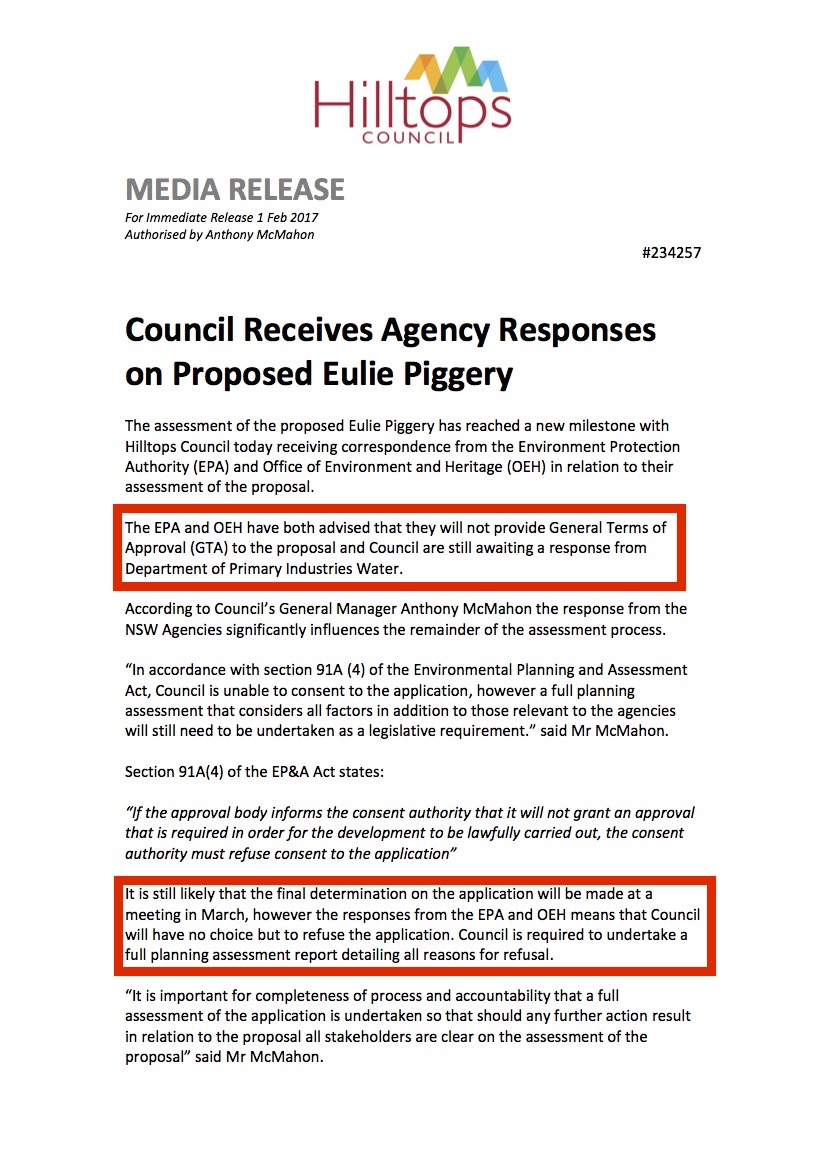
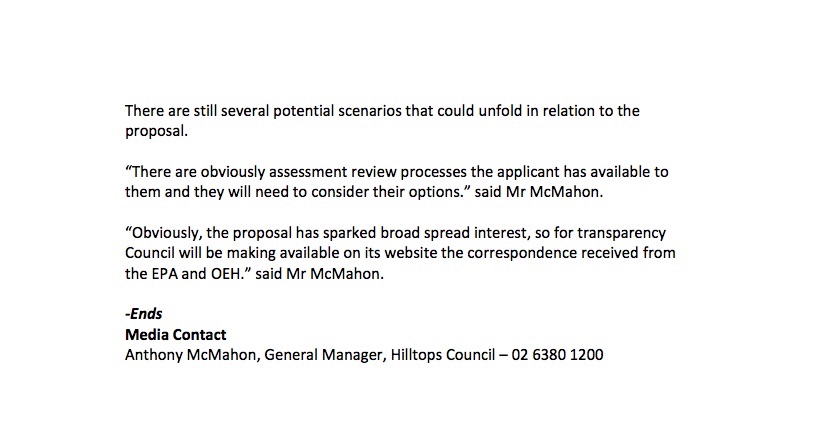
December 15, 2016 - The animal waste pathway in a mega-piggery explained
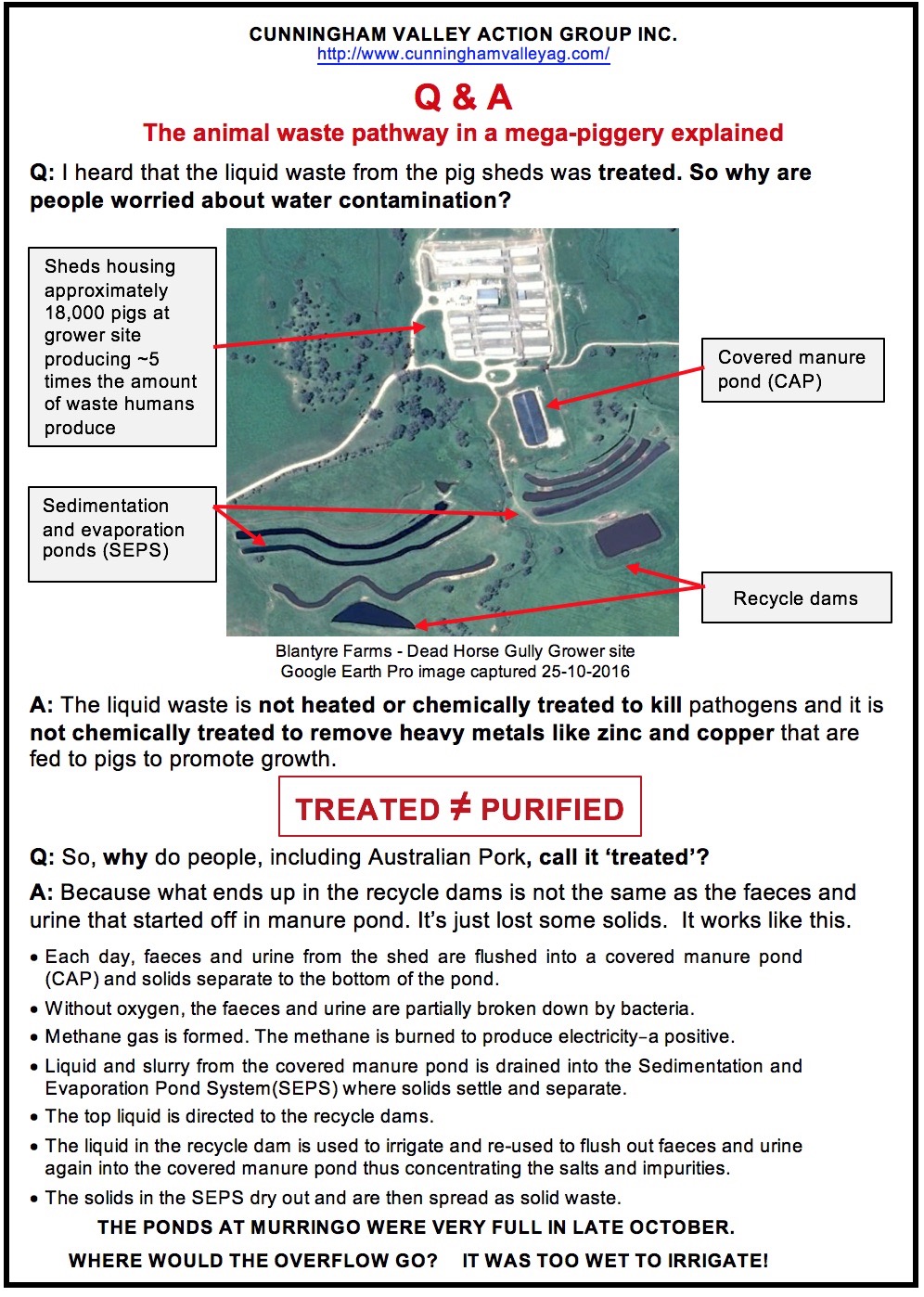
December 7, 2016 - Wrong location
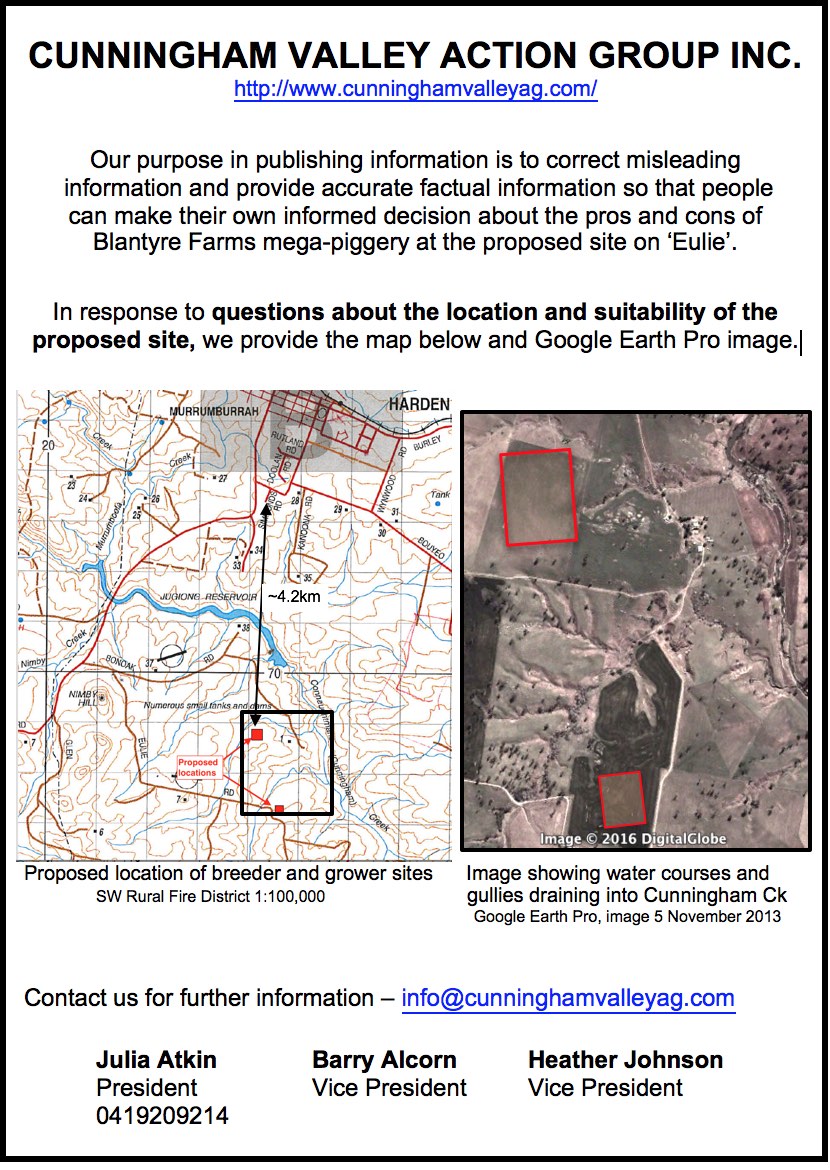
Since last December, Cunningham Valley Action Group’s (CVAG) main point has been that the proposed site is the wrong location for an intensive piggery. The proponent owns the land and has tried to fit an intensive piggery to the land. It doesn't fit! It's like a square peg in a round hole.
The proposal has not simply sat with Council for 12 months
. The proponent has repeatedly submitted material that contains numerous errors and inconsistencies and does not satisfactorily address the legislative requirements nor the questions of EPA, OEH and Hilltops Council. The situation is equivalent to someone walking into the Registry Office expecting to get a licence because they are confident they are a good driver. Obviously you can’t do that! You must first pass tests required for a licence – knowledge, practical and eye tests. It is not the fault of RMS staff if you fail these tests. For 12 months or more, EPA, OEH and Council has been asking for the evidence required for Blantyre Farms to pass the tests.
Does the amended EIS provide the evidence to pass the ‘tests’, to show that it can ‘fit’? Our review, so far, shows that it does not. A new EIS cannot change the features of the site.
Why doesn't it fit? The key reasons are summarised below.
The property cannot sustain the waste it produces. 25,000 pigs produce the waste of over 100,000 people. That waste has to be dealt with. The property is not large enough to spread the tonnes of animal waste sustainably. The proponent’s own consultant has concluded that solid animal waste will have to be taken off site. The EIS indicates at least 250 tonnes per year would need to be disposed of off site. Based on our review of the amended EIS, CVAG believes that to be a very conservative estimate. The EIS includes letters from two local farmers, Tony Flanery (Goorama Pty Ltd) and James Bowman (Tarraganda Pastoral Co), indicating they will spread Blantyre’s excess solid animal waste on their farms. This means the waste would have to be trucked through town to the north and north east where more people stand to be affected by odour. Have people forgotten the human biosolids debate?
This cannot be prevented beyond Eulie’s boundaries due to its size and shape It’s is an offence against the law to cause odour pollution. Usually piggeries buy up enough land to have a ‘buffer zone’ to make sure odour pollution is contained within their boundary.
The site is 4.2 km from the southern edge of town. There is a high risk of odour pollution for the people of Harden. People say they would like to see the town grow. Where? Would you build close to a mega-piggery?
There are real risks of groundwater depletion and surface and groundwater contamination. The proposed site is categorised as of moderately high groundwater vulnerability (susceptible of being contaminated by human activity) and it has very steep slopes to Cunningham Ck which is the drinking water catchment area for Harden, Temora, Cootamundra, Young and further downstream. All the neighbours’ dams leak due to the erodible soils even when they have been compacted the way the proponent intends to compact the manure ponds and evaporation ponds. The EIS fails to show how extensive surface run off from contaminated areas would be prevented from entering Cunningham Ck. Goldenfields Water is not equipped to deal with a major water pollution event.
The proponent was informed in August 2015 what the ‘tests’ were and so far has failed the ‘tests’. From our analysis, the new EIS still fails the tests. No matter how high the standard of ‘…management, it is no substitute for poor site selection’ (Australian Pork Limited NEGP 2010).
The map shown (below) is a visual display of landholders and residents who are concerned about one or more of the issues identified above. CVAG Inc welcomes questions.
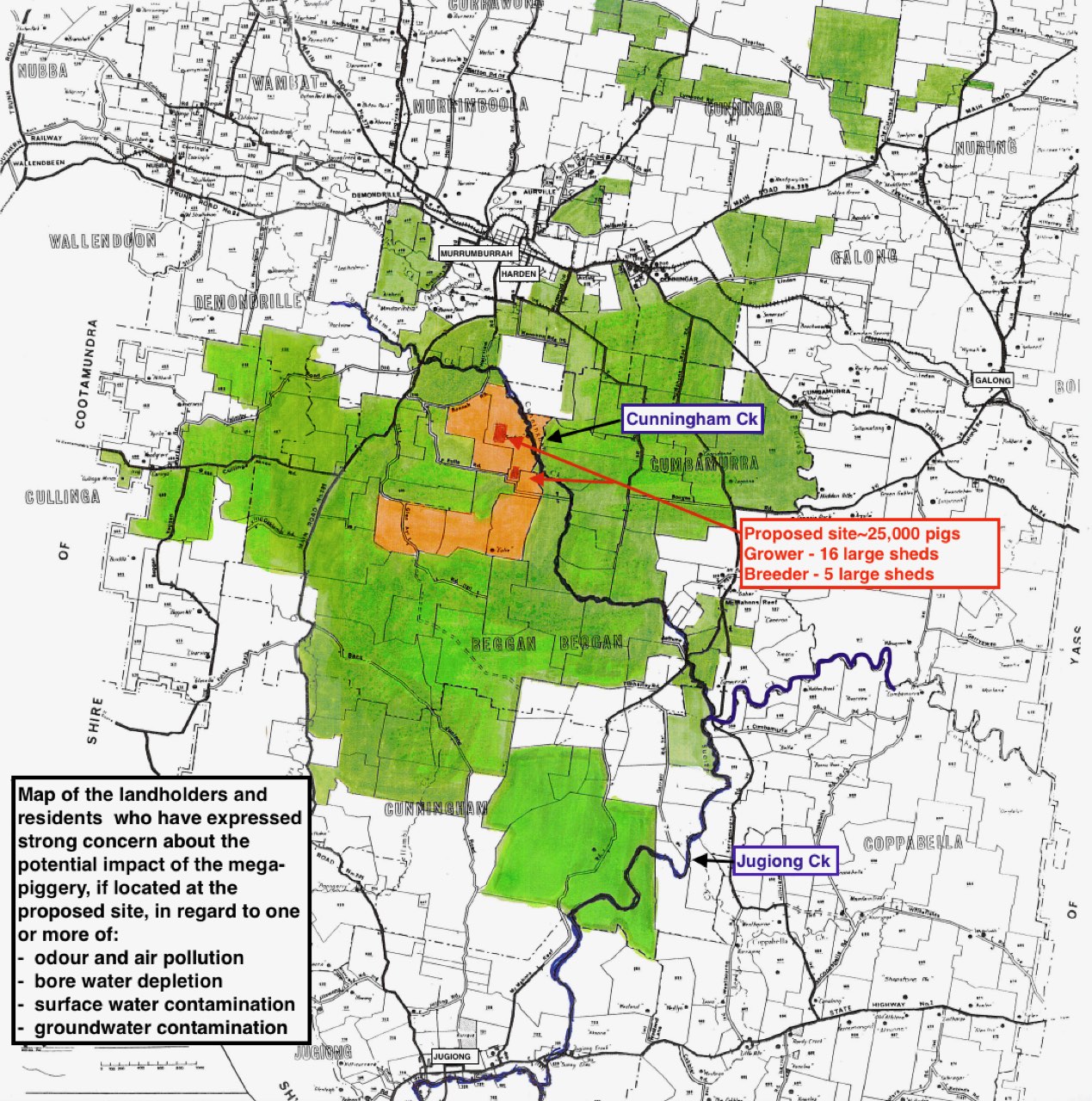
February 16, 2016 - Local landowners interviewed over proposed mega-piggery in Harden
A young Harden farmer expresses her concerns stating that the mega-piggery on an adjoining property will destroy her dreams of taking the family farm into the future.
The proposed piggery is in the wrong location. Soil type and proximity to a drinking water catchment area threaten the continuation of extensive agriculture in the region and the water supplies of Jugiong, Harden, Temora and Cootamundra
February 11, 2016 - Blantyre Farms submitted an inadequate, incomplete application making it impossible for Harden Shire to assess it.
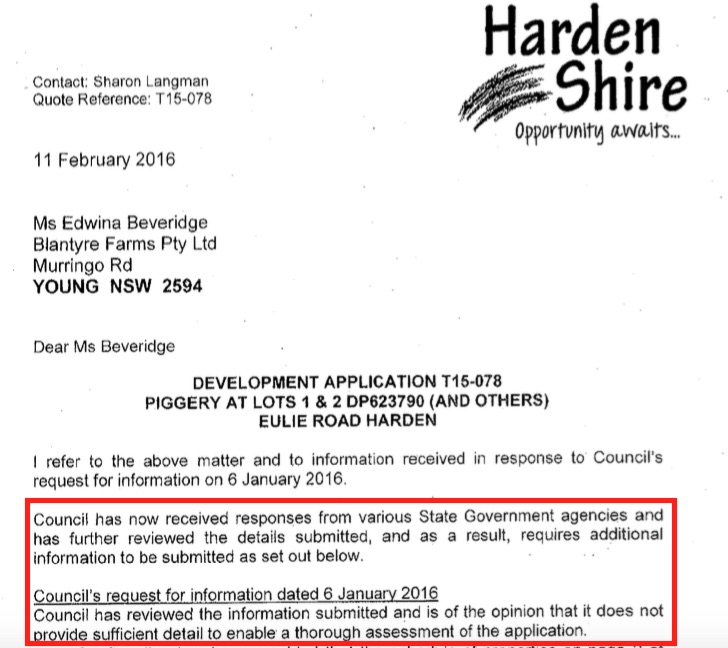
Why should we have faith in piggery operators, Blantyre Farms, to implement safe and appropriate practices if they cannot even provide sufficient detail and adequate community consultation to enable thorough assessment of their application?
The full 14 page response from Harden Shire Council to Blantyre farms proposal is available here
For the latest updates please visit our facebook page or contact us directly
If you have any personal concerns - from flies, to public health issues, to the impact on a traditional farming landscape - then consider lodging a submission with Harden Shire Council. A sample pro forma for submission is provided.
The Development Application (DA) and Environmental Impact Statement (EIS) from Blantyre Farms can be viewed here
The public exhibition period remains open til 5pm, February 5, 2016.
Anyone can lodge a submission in relation to the DA.
Submissions must be lodged by 5pm, February 5.
We will attempt to provide you with more information as it comes to hand.